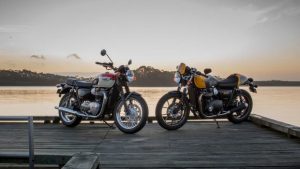
Triumph really has this retro-bike thing stitched up. In the last year, they have nailed it each and every time.
The Hinckley designers feel there is a rich vein of nostalgia throbbing in the arm of motorcycling, and they have just the syringe to explore it.
With these retro-styled bikes, or ‘modern classics’ as Triumph likes to call them, the factory has really come into its own.
So what’s a ‘modern classic’?
It’s a marketing term used to describe bikes that look like old-school oil-weepers but behave like modern motorcycles.
And both the T120 Bonneville and the Thruxton are on-point genre-perfect offerings.
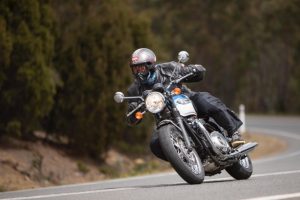 The T100 range has likewise perfectly nailed this modern classic look and combined it with a bike that rides very well, and is therefore a lot of fun to belt around on without going grey from terror.
The T100 range has likewise perfectly nailed this modern classic look and combined it with a bike that rides very well, and is therefore a lot of fun to belt around on without going grey from terror.
And I don’t think any other manufacturer has ever or will ever pull this off quite like Triumph’s doing it.
The Japs have tried it, but that Kwaka W800 was only ever trying to look like a Trumpy; as was Yammy’s old XS650.
Coventry Triumphs possessed an aesthetic rightness, that will always transcend modern motorcycle design, and which is only now being properly resurrected by Hinckley Triumph. Sure, Mr Bloor’s lads have had a few cracks at it in the past, but it’s only this last year that things have really started to gel for them.
The 2017 T100 and Street Cup are just the latest in a growing squadron of today’s-tech-driving-yesterday-style offerings.
And I rode them around Tasmania for four days, which was a special kind of special…
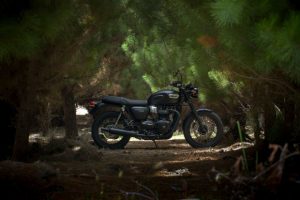
At the end of the second day, when I rolled into Hobart astride a dusty and hard-used T100, dry-mouthed and gummy-eyed, I felt like Steve McQueen, but without the supermodel girlfriends and Hollywood bank account.
In retrospect, it was kinda strange to be in the Steve zone.
I had not been hurtling through the Vegas desert. I had not been riding high-powered, precision-handling sports machines. I had not piloted naked firebreathers hammered in the forge of torque.
But I still felt like Steve.
And I had been riding the crap out of two fraternally-twinned Triumphs – mild mannered and well-handling, lovely to look at, and comfortable to ride – and different, but similar in many ways.
The T100 and the Street Cup are what Triumph views as the 900cc “entry level” bikes to its acclaimed 1200cc T120 Bonneville and Thruxton offerings.
The two variants, 900cc and 1200cc, share the same liquid-cooled, eight-valve, SOHC, 270-degree parallel-twin engine architecture.
The T100 and the T120 share a profile (as does the Street Cup and the Thruxton, but to a slightly lesser degree), but there are some key differences between the models.
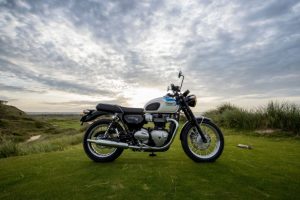
Firstly, there’s the displacement – 300cc is 300cc. The big ones just bang harder and the cammed-up Thruxton bangs hardest of them all.
But obviously not everyone wants or needs that kinda bang. Or the price that comes with it.
The T100 has no centre-stand, no grab-rail, no heated grips, and only a single disc up the front (the reduced weight actually makes it turn in a little sweeter than the T120), and while you still get traction control and ABS, you don’t get switchable engine modes.
But with a torque-delivery this smooth (you really need to be hammering hard before you start to feel a bit of a buzz through the bars), and a wonderfully tactile feel to the ride, I didn’t miss that at all. The T100 and Street Cup bang out about 55 horsies and a nice 80Nm of torque at 3230rpm, and while this is not going to win stop-light drags, these are very pleasant numbers to ride astride a machine that weights about 200kg.
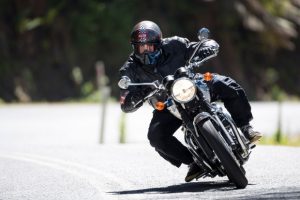
The gearbox shifts nut-sweet, neutral is easy to find, and the torque-assisted clutch is light and smooth. Good bottom-end torque and perfect fueling means traffic is a breeze – it happily chugs along at 1200rpm in top gear (there are only five gears), so as a daily commuter it’s bang on the money.
The only issue I had was with the fly-by-wire throttle and its refusal to behave like a MotoGP unit and respond in nano-seconds to my crazed inputs on the run from Queenstown to Strahan. I have to admit that I was making demands on it no-one else ever would, and in every universe Steve Martin is always going to be faster than me. But that must never stop a man and his fly-by-wire throttle from trying.
Once again, I would clarify that neither bike is at all the kind of motorcycle that one normally associates with hard-charging.
That of course did not stop any of the hard-charging that was going on. And you know something? It’s quite rewarding to be able to ride a motorcycle flat-out. And I rode the T100 and the Street Cup flat out, and it proved to be both joyous and instructive.
 If I did nothing else apart from load myself with oysters, I rode these two bikes as hard as I could, and came out smiling.
If I did nothing else apart from load myself with oysters, I rode these two bikes as hard as I could, and came out smiling.
How is this possible on bikes that top-out at just over 160km/h?
Tasmanian roads, that’s how.
But I’m also thinking another answer is because getting a good pace on comes down to you, the rider. On bikes like the T100, you can’t rely on massive torque and killer horsepower to make up for you being slow in corners. You can’t just twist the throttle after you’ve screwed up a bend and rely on the bike’s power to assuage your shame. Being respectably quick on a T100 or a Street Cup requires determination and unrelenting focus – crucial skills for people who ride motorcycles.
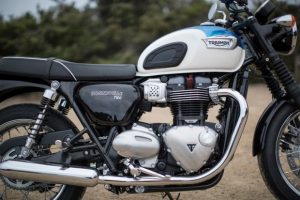
It also helps if the bike handles well, and both of these new Triumphs did not disappoint in that regard. There were times when I had the throttle pinned and was sailing through sweeper after sweeper with a song in my heart and a rock-steady red-lining twin under my belly. There were other times when I was levering it from side to side, over and over, world without end (there are no straight roads in Tassy) and working the gearbox like a Yemeni slave, and not once did it startle me or seek to end my life. And that was at the pointy end (and maybe a little on the other side) of its design brief.
I’m pretty sure that no-one who buys a T100 or a Street Cup will ever ride it as hard as some of them were ridden on the press launch, but they can sleep easily knowing just how hard they can indeed be fanged.
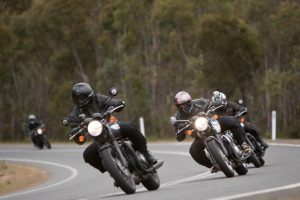
Neither bike put a tyre wrong though thousands of bends, one whole day of rain, and some 40km of dirt.
The new T120s and T100s look sensational and perform wonderfully well. And it’s interesting to note that in the United Kingdom, the T100 and the Street Cup are available in a Learner Legal form. Which is all kinds of brilliant if you’re 16-years-old, huh?
But even in the form in which I rode them, they would make spectacular Learner’s bikes (as if our owners would ever come to their senses and permit this), or bikes for people who want something that looks splendid, has a great deal of motorcycle integrity in terms of on-road behaviour, but feel they don’t need a bike defined purely by power.
The T100 and the Street Cup are as good as they come for those people.
Triumph has indeed had a great 2016, and it looks like it’s going to have an even better 2017.
SO WHAT’S THE DIFFERENCE BETWEEN THE T100 THE STREET CUP?
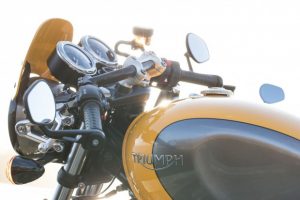 As I said earlier, these are fraternal twins. They are identical in many ways, and different in a few others.
As I said earlier, these are fraternal twins. They are identical in many ways, and different in a few others.
Aesthetically, the T100 is, for all intents and purposes, a smaller capacity Bonneville T120. The Street Cup on the other hand is more a café-racered T100 than it is a Thruxton with a smaller engine.
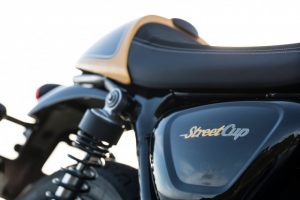 It shares the Thruxton’s instrument cluster and foot-pegs, and the T100’s petrol tank, but in keeping with its more café-racery schtick, comes with a rear-seat cowl, shorter pipes, a different seat and drop-bars. It also has slightly longer rear shocks, which tilt the bike and you forward in a slightly more aggressive posture, perfectly in keeping with the Street Cup’s game. It also has cast wheels rather than the spokes gracing the T100, which I prefer, but then manufacturers don’t build bikes to please me alone, more’s the pity.
It shares the Thruxton’s instrument cluster and foot-pegs, and the T100’s petrol tank, but in keeping with its more café-racery schtick, comes with a rear-seat cowl, shorter pipes, a different seat and drop-bars. It also has slightly longer rear shocks, which tilt the bike and you forward in a slightly more aggressive posture, perfectly in keeping with the Street Cup’s game. It also has cast wheels rather than the spokes gracing the T100, which I prefer, but then manufacturers don’t build bikes to please me alone, more’s the pity.
The Street Cup’s seat is firmer than the T100s, has contrasting hand-applied stitching and is made from wild Alcantara pelts (like the Thruxton) and the best bar-ends ever made (also like the Thruxton).
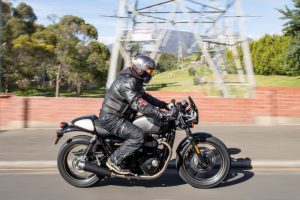
I preferred the Street Cup to the T100. The riding position made it (and me) was just more suited to neck-wringing. And I didn’t find it was uncomfortable despite the lower handlebars. Humans taller than six-four on the old scale with giraffe-like legs and elongated torsos might think differently, but why should anyone build bikes for the deformed?
I think it is stunning to look upon – especially in silver. I liked the hell out of it in yellow, but the silver was just special. They’re the only two colours it comes it.
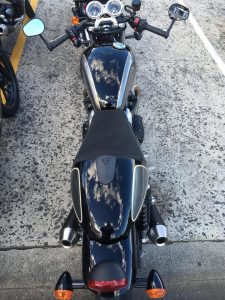 Unlike the T100. That you can have in white with a blue tank flash, white with an orange tank flash, or black. There is also a T100 Black which comes in either matte or gloss variations of heaps more blackness. Happily none of them come with a brown seat.
Unlike the T100. That you can have in white with a blue tank flash, white with an orange tank flash, or black. There is also a T100 Black which comes in either matte or gloss variations of heaps more blackness. Happily none of them come with a brown seat.
The Street Cup’s got some small aesthetic glops like the wiring I can see between the seat and the frame, but as a complete package, it is quite one of the prettiest bikes on the market. Especially when you trick it up with some Vance & Hines cans and Fox piggy-back rear shocks you can get through the Triumph aftermarket catalogue.
In fact, there’s a whole bunch of post-buy goodies available for both the T100 and the Street Cup, and Triumph did build them with that kind of customisation in mind.
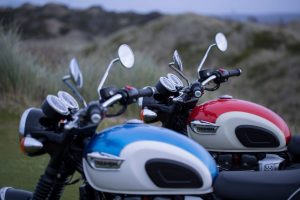
HOW MUCH?
The T100 $15, 300 plus ORC
The T100 Black $15,500 plus ORC
The Street Cup $15,300 plus ORC
TECHNICAL STUFF
You may view the specs for the Street Cup at
http://www.triumphmotorcycles.com.au/bikes/classics/street-cup/2017/street-cup
The specs for the T100 can be found at
http://www.triumphmotorcycles.com.au/bikes/classics/bonneville/2017/bonneville-t100
Words by Boris Mihailovic
